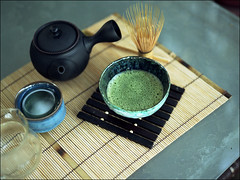Raku ware is a type of Japanese pottery that is traditionally used in the Japanese tea ceremony, most often in the form of tea bowls, says Wikipedia.
It is traditionally characterised by being hand shaped rather than thrown; fairly porous vessels, which result from low firing temperatures; lead glazes; and the removal of pieces from the kiln while still glowing hot. In the traditional Japanese process, the fired raku piece is removed from the hot kiln and is allowed to cool in the open air or in a container filled with combustible material.
Raku means "enjoyment", "comfort" or "ease" and is derived from Jurakudai, the name of a palace, in Kyoto, that was built by Toyotomi Hideyoshi (1537–1598), who was the leading warrior statesman of the time.
In the 16th century, Sen Rikyū, the Japanese tea master, was involved with the construction of the Jurakudai and had a tile-maker, named Chōjirō, produce hand-moulded tea bowls for use in the tea ceremony that was Rikyū's ideal.
Hideyoshi presented Jokei, Chōjirō's son, with a seal that bore the Chinese character for raku[1]. Raku then became the name of the family that produced the wares. Both the name and the ceramic style have been passed down through the family to the present 15th generation (Kichizaemon).
The name and the style of ware has become influential in both Japanese culture and literature.
Raku became popularized in America in the late 1950s with the help of Paul Soldner. Americans kept the general firing process, that is, heating the pottery quickly to high temperatures and cooling it quickly, but continued to form their own unique style of raku.
It is raku’s unpredictable results and intense color that attract modern potters. These patterns and color result from the harsh cooling process and the amount of oxygen that is allowed to reach the pottery. Depending on what effect the artist wants, the pottery is either instantly cooled in water, cooled slowly in the open air, or placed in a barrel filled with combustible material, such as newspaper, covered, and allowed to smoke[11]. Water immediately cools the pottery, stopping the chemical reactions of the glaze and fixing the colors. The combustible material results in smoke, which stains the unglazed portions of the pottery black. The amount of oxygen that is allowed during the firing and cooling process affects the resulting color of the glaze and the amount of crackle.
Unlike traditional Japanese raku, which is mainly hand built bowls of modest design, western raku tends to be vibrant in color, and comes in many shapes and sizes.
Subscribe to:
Post Comments (Atom)





No comments:
Post a Comment